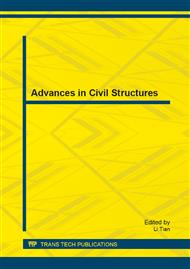p.695
p.699
p.704
p.708
p.713
p.717
p.722
p.726
p.730
Calculation of Load-Carrying Capacity of Square Concrete Filled Tube Columns Based on Neural Network
Abstract:
Steel tube and filled concrete of square CFT columns under axial load are in complicated stress condition, the influence of every kind of factors on mechanics performance is difficult to ascertain accurately. On the other hand, neural network is good at obtaining the relationship between input and output variables by self-studying, self-organizing, self-adapting and nonlinear mapping. Therefore, it is suitable that use neural network to calculating the bearing capacity of square CFT columns. In this paper a three-layer back-propagation model of network is trained according to experimental data of square CFT columns under axial load, a neural network model for axial loaded square CFT columns is set up. The model is verified by six groups of experimental data, the results show the predicted values are in good agreement with test values, precision in calculation is good enough to be used as an auxiliary method for structure design.
Info:
Periodical:
Pages:
713-716
Citation:
Online since:
August 2013
Authors:
Price:
Сopyright:
© 2013 Trans Tech Publications Ltd. All Rights Reserved
Share:
Citation:


